Sea lions and seals, while both members of the pinniped family, have distinct traits that set them apart. Key differences lie in their physical features and behaviors:
Sea lions are characterized by external ear flaps and long, rotating hind flippers that facilitate smooth movement on land. Whereas seals lack external ears and have short, webbed flippers. They are adapted more for efficient swimming than terrestrial mobility. Moreover, sea lions tend to be more social and vocal than seals.
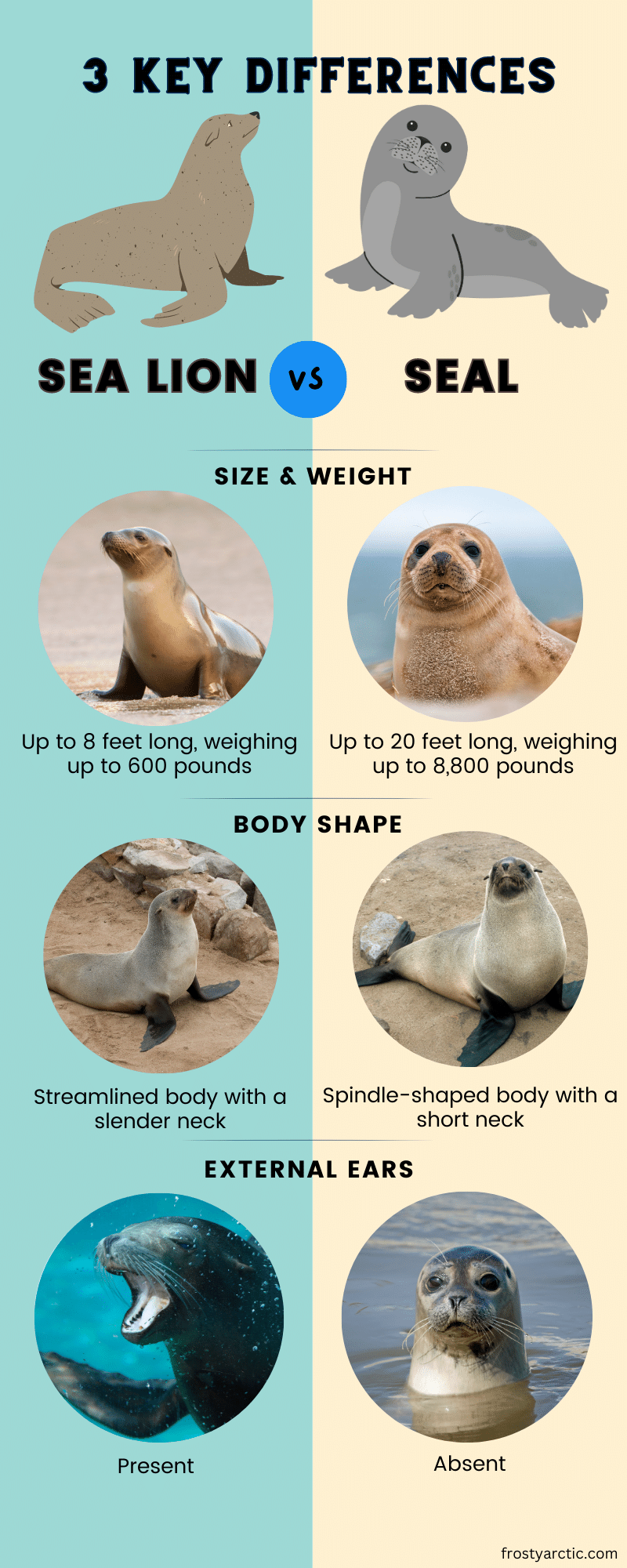
The ocean, a world of awe-inspiring biodiversity, houses many remarkable creatures, including sea lions and seals. Both of these animals share a marine lifestyle yet exhibit distinct differences that make them uniquely fascinating.
Ready to dive deep into the details? Join us as we explore the mysteries of these incredible marine mammals. Hold tight, as we’re about to undertake an exciting underwater journey!
Sea Lion vs Seal: A Quick Comparison
Let’s take a quick look at the differences between these two creatures.
| Feature | Sea Lion | Seal |
| Family | Otariidae | Phocidae |
| Body Shape | Streamlined body with a slender neck | Spindle-shaped body with a short neck |
| External Ears | Present | Absent |
| Skin | Thick fur coat | Thin fur with a layer of blubber underneath |
| Size | Up to 8 feet long, weighing up to 600 pounds | Up to 20 feet long, weighing up to 8,800 pounds |
| Diet | Primarily fish and squid | Various fish, invertebrates, and shellfish |
| Habitat | Pacific Ocean, coastal and open water | Found in both tropical and colder climates, coastal waters |
| Social Behavior | Highly social, form colonies | Less social, often solitary or in small groups |
| Locomotion on Land | Can walk using all four flippers | Move by wriggling their bodies and pushing forward with their fore flippers |
| Lifespan | Up to 30 years | Up to 35 years |
| Gestation period | About 9 months, a single pup born | About 9-11 months, a single pup born |
| Conservation status | Varies by species (e.g., Least Concern to Endangered) | Varies by species (e.g., Least Concern to Endangered) |
Sea Lion vs Seal – What Are The Key Differences?
Sea lions and seals share a similar amphibious lifestyle but are quite different creatures. Their sleek, aquatic bodies and flipper-based movements might make it seem like they’re close cousins. But, there are crucial differences that set them apart.
So, let’s dive beneath the surface and explore the unique characteristics that differentiate these fascinating ocean dwellers.
01. Taxonomy and Scientific Classification
Sea Lions and Seals belong to different families within the order Carnivora.
Sea Lion

Sea Lions belong to the Otariidae family, also known as “eared seals.” According to the Handbook of Marine Mammals, six common species of Sea Lions include:
- Steller Sea Lion (Eumetopias jubatus)
- California Sea Lion (Zalophus californianus)
- South American Sea Lion (Otaria flavescens)
- Australian Sea Lion (Neophoca cinerea)
- Southern sea lion (Otaria byronia)
- New Zealand sea lion, also known as Hooker’s sea lion (Phocarctos hookeri)
Seal
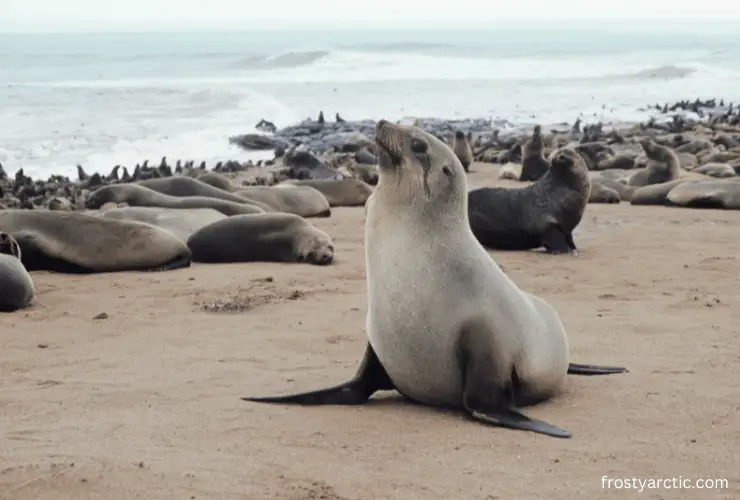
Seals, also known as true seals or earless seals, belong to the Phocidae family. Several common species of seals, as documented in the Manx Marine Environmental Assessment, include:
- Harbor Seal (Phoca vitulina)
- Grey Seal (Halichoerus grypus)
- Harp Seal (Pagophilus groenlandicus)
- Hooded Seal (Cystophora cristata)
- Leopard Seal (Hydrurga leptonyx)
- Weddell Seal (Leptonychotes weddellii)
| Classification | Sea Lion | Seal |
| Kingdom | Animalia | Animalia |
| Phylum | Chordata | Chordata |
| Class | Mammalia | Mammalia |
| Order | Carnivora | Carnivora |
| Family | Otariidae | Phocidae |
| Genus | Varies (Eumetopias, Zalophus, Otaria, etc.) | Varies (Phoca, Halichoerus, Pagophilus, etc.) |
| Species | Varies (E. jubatus, Z. californianus, O. flavescens, etc.) | Varies (P. vitulina, H. grypus, P. groenlandicus, etc.) |
02. Habitat and Distribution
Sea Lions and Seals are both marine mammals. However, they prefer different habitats and are found in different geographical locations.
Sea Lion
Sea Lions are predominantly found in the Pacific Ocean, but some species also inhabit southern Atlantic regions. Here are the primary habitats of Sea Lions:
- Bering Sea
- Southern South America
- Tierra del Fuego
- Falkland Islands in the Southern Atlantic Ocean
- Australia
- New Zealand.
They prefer temperate and subarctic waters and are widespread, inhabiting a variety of marine environments, from open oceans to coastal shallows.
Sea Lions are often seen chilling on the shores of coastal areas, islands, and even navigational buoys. As noted by the Marine Mammal Center, they move to rocky and sandy beaches for breeding and resting.
Seal
Seals have a broad geographical distribution, encompassing the Arctic, Antarctic, and most temperate and tropical waters in between. Seal species show preferences for different types of habitats:
- Harbor Seal: Northern hemisphere in both Atlantic and Pacific Oceans
- Grey Seal: North Atlantic
- Harp Seal: Arctic and northernmost Atlantic
- Hooded Seal: Central and Western North Atlantic
- Leopard Seal: Antarctic
- Weddell Seal: Antarctic
Seals prefer a variety of habitats, including both coastal and open ocean environments. They haul out onto land or ice to rest, molt, and breed.
| Aspect | Sea Lions | Seals |
| Habitat | Temperate to subarctic marine waters | Varies widely from the Arctic to Antarctic and tropical waters |
| Habitat Preferences | Ocean floor, Rocky and sandy beaches, Coastal areas | Ocean floor, Ice floes (for some species), Rocky and sandy beaches, Coastal areas |
| Distribution | Primarily Pacific Ocean | Global: Arctic, Antarctic, and most temperate and tropical waters |
03. Physical Appearance
Sea Lions and Seals, both part of the pinniped family, have distinctive physical appearances.
Sea Lion
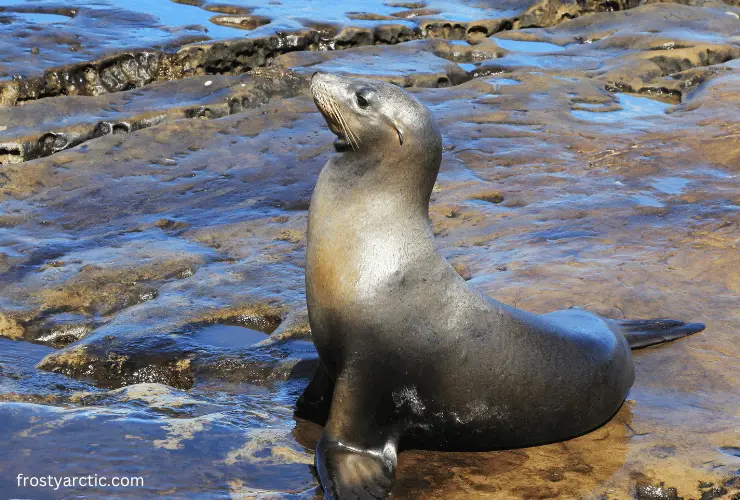
- Shape and Size: Sea Lions have a streamlined body shape designed for agility in the water, with adult males typically larger than females. The length varies among species, with the Steller Sea Lion being the biggest. It can reach lengths up to 10 feet (males) and weigh over 1,120 kg.
- Coloration: Sea Lions typically have a brownish or tan coloration that darkens when wet and lightens when dry.
- Flippers: They have large, long front flippers that they use for propulsion in the water and to walk on land.
- Ears: Sea lions also have external ear flaps that distinguish them from “true” seals.
Seal
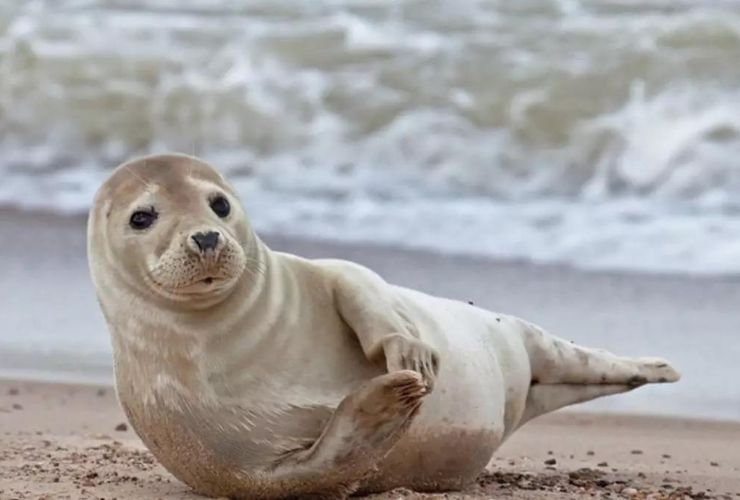
- Shape and Size: Seals have a more rounded body shape, with the larger males reaching more than 20 feet long in species such as the Southern elephant seal. ~ Source
- Coloration: Seals’ fur can vary from white, as in the Harp Seal, to brown or black, as in the Leopard Seal. They often have a mottled pattern.
- Flippers: Seals have short, clawed flippers that are excellent for swimming but make movement on land an awkward, belly-sliding shuffle.
- Ears: Unlike sea lions, seals lack external ear flaps and instead have small holes for ears.
| Physical Feature | Sea Lion | Seal |
| Body Shape | Streamlined | Rounded |
| Size | Up to 10 feet long (males of Steller Sea Lion) | Up to 20 feet long (males of Southern Elephant Seal) |
| Color | Typically brown or tan | Varied (white, gray, brown, or black); often mottled |
| Front Flippers | Large and long | Short and clawed |
| External Ears | Present | Absent |
04. Diet and Feeding Habits
Although both Sea Lions and Seals are carnivorous marine mammals, their diet preferences and feeding habits vary considerably.
Sea Lion
Sea Lions primarily feed on a variety of fish species and cephalopods. The specifics can vary between species and regions, but the diet often includes the following:
- Squid
- Octopus
- Pollock,
- Rockfish
- Herring
- Salmon
- Anchovies.
They occasionally consume crustaceans and other invertebrates when fish and cephalopods are less available.
According to a study published in Aquatic Mammals, an adult Sea Lion can consume about 25 to 40 kg of prey daily.
Sea Lions are known for their agile swimming skills and sharp teeth, which they use for catching and tearing apart their prey.
Seal
Seals have a diverse diet that often includes a range of fish and invertebrates. Diet can vary by species and region, but some common prey include:
- Cod
- Herring
- Flounder
- Squid
- Octopus
- Shellfish
- Krill
According to a North Atlantic Marine Mammal Commission report, seals often hunt at depths of hundreds of meters, relying on their excellent swimming skills and sensitive whiskers to locate prey. They have sharp teeth and strong jaws to catch and chew their prey.
| Aspect | Sea Lion | Seal |
| Diet | Primarily fish and cephalopods, occasionally crustaceans and other invertebrates | Varied, but often includes a range of fish, squid, octopus, and invertebrates |
| Feeding Habits | Agile swimmers; use sharp teeth for catching and tearing apart prey | Excellent divers and opportunistic feeders; use teeth and strong jaws to catch and chew prey |
| Daily Consumption | Approximately 5% to 8% of their body weight | Variable, depending on available prey and feeding conditions |
05. Social Behavior
Sea Lions and Seals are both friendly mammals but exhibit different social behaviors, communication methods, and territorial tendencies.
Sea Lion
Sea Lions are highly social animals that live in large, vocal colonies. They have a complex social structure that includes both females and males, with the larger males being dominant and maintaining the harems of females.
Males become highly territorial during the breeding season, often defending their harems against other males through aggressive displays and vocalizations.
Communication among Sea Lions is multifaceted and involves a range of vocalizations, such as barks, roars, and grunts, along with physical posturing and direct interactions.
Seal
Seals also have complex social structures. They are generally less social than sea lions, although their behavior can vary significantly by species. For example, harbor seals are largely solitary, while grey seals often form large colonies.
Seals can be territorial, especially during the breeding season, as noted by the National Oceanic and Atmospheric Administration. Males typically display aggressive behavior to protect their space and their mates.
Communication in seals involves a variety of vocalizations, body movements, and touch. Vocalizations can include trills, sweeps, growls, moans, grunts, and roars, used for various purposes such as attracting mates, warning off rivals, or maintaining contact with pups. ~ Source
| Aspect | Sea Lion | Seal |
| Social Structure | Large colonies with male-dominant harems | Varies by species, from largely solitary to forming large colonies |
| Aggression | Males display aggression during the breeding season | Males can be aggressive, especially during the breeding season |
| Communication | Use vocalizations, body posturing, and physical interactions | Use vocalizations, body movements, and touch |
06. Reproduction and Lifecycle
Sea Lions and Seals have unique reproductive behaviors and lifecycles that are highly adapted to their marine environments.
Sea Lion
- Mating behavior: Sea Lions display sexual dimorphism, with males being much larger than females. They have a polygynous breeding system, with dominant males forming harems of females during the breeding season.
- Mating season: The breeding season for Sea Lions typically falls in the summer months.
- Gestation period: After mating, the gestation period lasts approximately 9-12 months, including a three-month delayed implantation period.
- Pups: Females give birth to a single pup, which they nurse for about six months to a year. In some species, the mother-pup bond can last for several years.
- Sexual maturity: Sea Lions reach sexual maturity at about 3-6 years for females and 5-10 years for males, varying by species.
- Lifespan: The typical lifespan of a Sea Lion can be up to 20 years for males and up to 30 years for females.
Seal

- Mating behavior: Seals also exhibit sexual dimorphism, with males generally larger than females. They have a polygynous mating system, but males do not form harems. The breeding process is less aggressive.
- Mating season: Seals breed during various seasons depending on the species, but most often in the summer or fall. Males will compete for females, though the competition is typically less intense than in sea lions.
- Gestation period: The gestation period for seals varies by species, but it typically ranges from 9 to 11 months, including a delayed implantation period.
- Pups: Seals usually give birth to a single pup. The mother nurses the pup for a variable length of time, depending on the species, ranging from a few weeks to several months. ~ Source
- Sexual maturity: As detailed in Reviews of Reproduction, Seals reach sexual maturity at around 3-6 years for females and 9-15 years of age for males, varying by species.
- Lifespan: The typical lifespan of a seal can be up to 25-30 years for both males and females, though this can vary greatly by species.
| Aspect | Sea Lion | Seal |
| Mating Season | Summer months | Varies by species, usually summer or fall |
| Gestation Period | Approximately 9-12 months (including delayed implantation) | Approximately 9-11 months (including delayed implantation) |
| Pup/Calf | Single pup, nursed for 6 months to a year | Single pup, nursed for a few weeks to months |
| Sexual Maturity | Females: 3-6 years, Males: 5-10 years | Females: 3-6 years, Males: 9-15 years |
| Lifespan | Males: Up to 20 years, Females: Up to 30 years | Up to 25-30 years |
07. Natural Predators
Sea Lions and Seals, although they are sizable marine creatures, still have natural predators in their environment.
Sea Lion
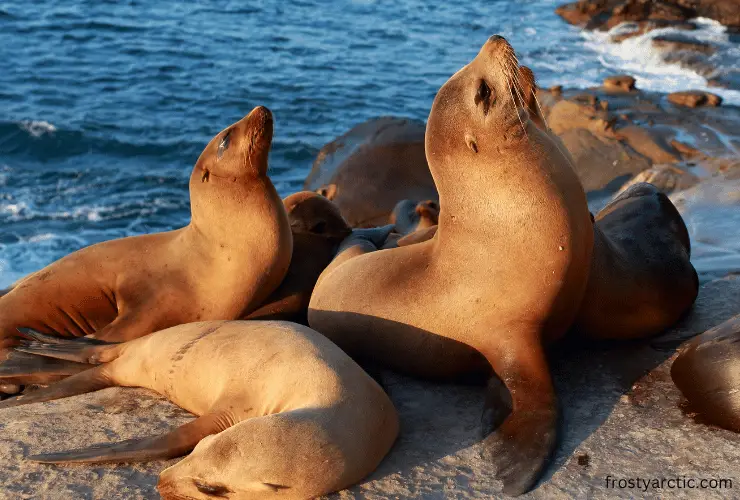
Sea Lions face threats from many oceanic and terrestrial predators. In the ocean, their primary predators are
- Orcas (Killer Whales)
- Large shark species, such as the Great White Shark and Tiger Shark.
On land, juveniles, particularly pups, may fall prey to terrestrial predators like
- Coyotes
- Large birds of prey.
Seal
Predation on seals is primarily ocean-based. The main predators include
- Killer Whales,
- Large shark species (like the Great White Shark),
- Larger seals (occasionally).
On land, terrestrial predators can pose a threat to pups. These include
- Polar bears,
- Foxes,
- Birds of prey
| Species | Natural Predators |
| Sea Lion | Orcas, Great White Sharks, Tiger Sharks, Coyotes, Birds of prey |
| Seal | Orcas, Great White Sharks, Larger seals, Polar bears, Foxes, Birds of prey |
08. Defense Mechanism
Both Sea Lions and Seals have unique defense mechanisms to protect themselves from predators.
Sea Lion
Sea Lions rely heavily on their speed and agility to escape threats. They can swim at speeds up to 25 mph. ~ Source
They also utilize group strategies, wherein individuals alert each other to danger. Adult Sea Lions defend themselves on land using their sharp teeth and powerful jaws.
Seal
Seals primarily rely on their excellent swimming abilities and agility in the water to evade predators. According to an article published in the journal PLOS ONE, they can rapidly change direction and dive deep underwater to escape from threats.
Seals may also use their strong jaws and sharp canine teeth in defense if cornered or threatened. Some seal species use pack ice or crowded beaches to protect against potential predators.
| Species | Defense Mechanism |
| Sea Lion | Can swim up to 25 mph in water; Group strategies, Use of sharp teeth and powerful jaws on land |
| Seal | Excellent swimming abilities, rapid change in direction, deep diving, use of strong jaws, sharp canine teeth, pack ice or crowded beaches |
09. Interaction With Humans
Human interaction with both Sea Lions and Seals also varies.
Sea Lion
Sea Lions are a favorite among tourists. They are often the star attractions at zoos and aquariums due to their intelligence and playful nature. They are trained to perform tricks and engage with the audience in many marine parks.
However, Sea Lions can be a nuisance for fishermen as they are known to steal fish and damage nets.
Historically, Sea Lions have been hunted for their hides and oil, and this practice continues in some parts of the world, despite international protection in many regions.
Seal
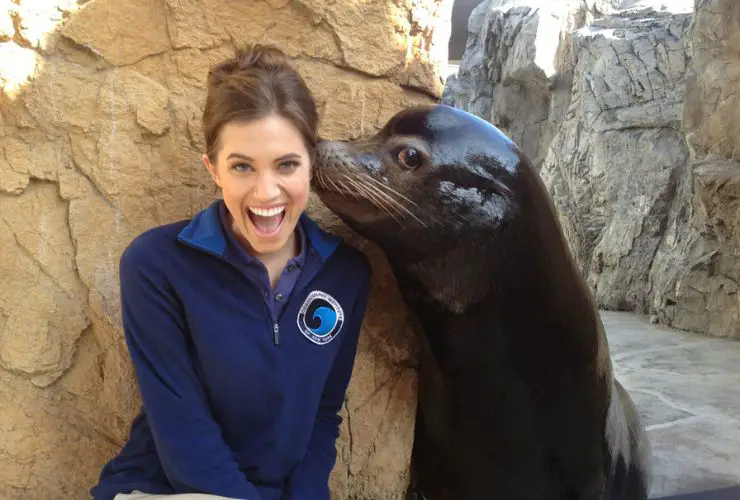
Seals are often observed and photographed by humans, especially in areas where they haul out on popular beaches. This can disturb their resting and breeding behaviors.
Fishermen also view them as competitors, as they are known to take fish from nets. Historically, seals have been hunted for their coat, meat, and oil, especially the Harp Seal. Although many countries have regulations to protect seals, illegal hunting and trade still persist in some regions.
| Aspect | Sea Lion | Seal |
| Tourism | Often found in zoos, aquariums, and marine parks due to their interactive nature | Often observed and photographed in their natural habitat |
| Conflicts with Fishermen | Known to steal fish and damage nets | Viewed as competitors by fishermen |
| Hunting | Historically hunted for hides and oil; some hunting still occurs despite protections | Historically hunted for their fur, meat, and oil; illegal hunting and trade still persist in some regions despite protections |
10. Threats and Conservation Status
Both Sea Lions and Seals face various threats from natural and human-induced environmental changes. The specific threats to each species and their conservation status vary considerably.
Sea Lion
Sea Lions face threats from multiple fronts, including
- Overfishing
- Entanglement in fishing gear
- Climate change
- Habitat degradation
According to the IUCN, the conservation status of Sea Lions varies among species: The Steller Sea Lion is “Near Threatened”, the California Sea Lion is “Least Concern”, and the Australian Sea Lion is “Endangered”.
Seal
Seals also face several threats. Climate change is a significant concern, particularly for ice-dependent species like the Harp and Ringed seals. The melting ice reduces their habitat and affects the abundance and distribution of their prey.
They are also often entangled in fishing gear, and in some areas, they are still hunted for their fur, meat, and blubber.
According to the IUCN, the conservation status of Seals varies greatly among species. For example, the
- Mediterranean Monk Seal is “Endangered,”
- Harbor Seal, Grey Seal, Harp Seal, Leopard Seal, and Weddell Seals are of “Least Concern”.
- Hooded Seal is “Vulnerable”
Conservation efforts for both Sea Lions and Seals involve protecting their habitats, managing fisheries, and enforcing regulations against hunting.
| Aspect | Sea Lion | Seal |
| Common Threats | Overfishing, entanglement in fishing gear, habitat degradation, climate change. | Climate change, entanglement in fishing gear, hunting |
| IUCN Status | Varies greatly among species (e.g., Near Threatened to Endangered) | Varies greatly among species (e.g., Least Concern, vulnerable to Endangered) |
11. Sea Lions vs. Seal: Who Would Win
Sea lions have a more muscular body than seals. They are known for their loud barking and ability to “walk” on land using their large flippers. They also have visible ear flaps.
These characteristics could give them an advantage in a confrontation on land, as they could potentially maneuver more effectively and use their large flippers for defense or offense.
Another thing is sea lions are more courageous and territorial. So they are better at defending themselves in fights.
Seals, however, are more rounded and lack visible ear flaps. They move on land by wriggling on their bellies, which could be a disadvantage in a land-based confrontation.
However, seals have shorter front and hind fur-covered flippers with long claws, which could be used effectively in a fight, especially in the water.
In terms of size, sea lions are generally larger than seals, which could give them a physical advantage in a matchup.
So, because of the sea lion’s muscular body and aggressive nature, it would likely win in a face-off with a seal.
Wrapping Up
So, are sea lions and seals the same? Not quite. These two remarkable marine mammals often interchanged in popular language, actually boast a host of unique features and behaviors that clearly distinguish them from one another.
Sea lions are typically found frolicking in the more temperate coastal regions. In contrast, seals inhabit a broader range of environments, from tropical to frigid polar waters.
Despite these differences, both creatures offer a captivating glimpse into the world beneath the waves, each adding unique chapters to the larger narrative of marine life.
We hope this exploration has deepened your understanding and appreciation of the vibrant biodiversity of our oceans. Don’t hesitate to dive back in for more insightful comparisons!

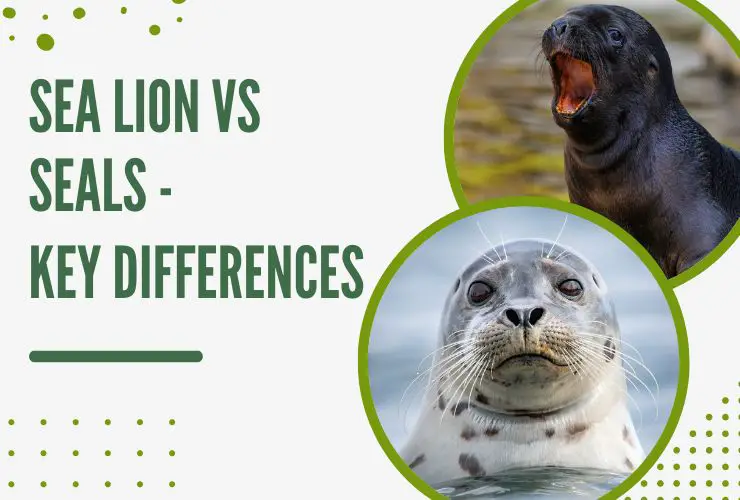

4 thoughts on “Sea Lion Vs Seal: Key Differences & Battle Winner”